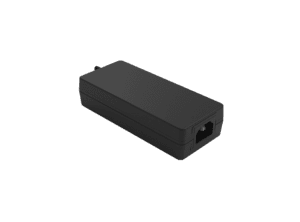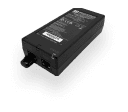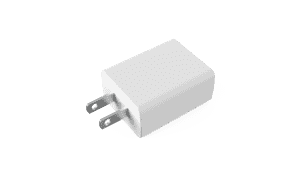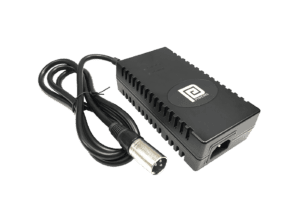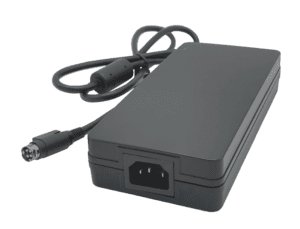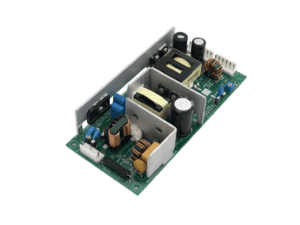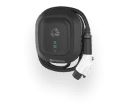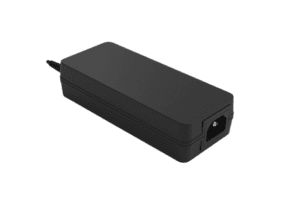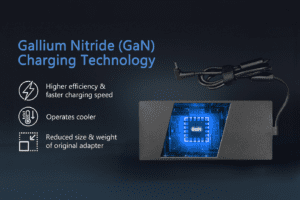BLOG
Battery Chargers: Charging into the Future
Table of contents
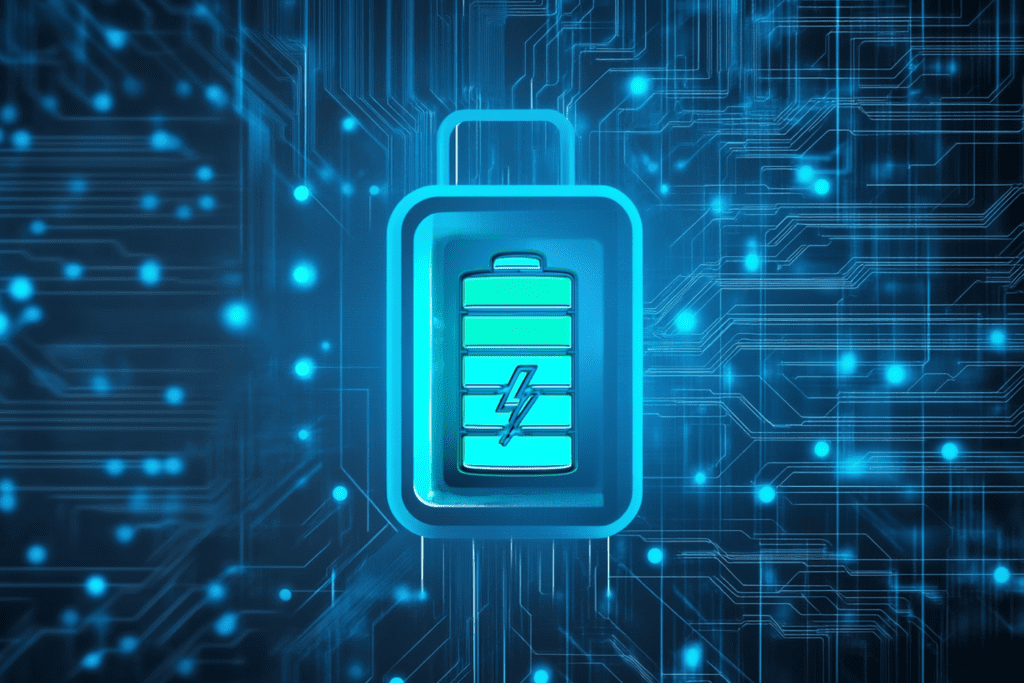
Battery chargers have evolved alongside our favorite portable devices for several decades. Nowadays, battery chargers have become internal circuitry within the devices themselves. So, if battery chargers are sneaking their way inside devices, what does the future hold for external battery chargers?
In this article we will explain the modern applications, the different types, safety certifications, and the role battery chargers will continue to have in our daily lives in the coming future.
What is a Battery Charger?
Before we get into what a battery charger is, we first must clear up the notion that battery chargers and adapters are synonymous. To differentiate between the two, consider this straightforward analogy:
Imagine your device is a car. The power adapter is like a gas station pump, converting the station’s fuel (AC) into a form your car can use (DC). On the other hand, a battery charger acts as a regulator, ensuring that the fuel (electricity) goes into the tank (battery) at the appropriate pressure (current) and stops the flow when the tank is full.
The adapter’s primary role is to transform AC electricity from the wall outlet into DC electricity, rectifying the wild alternating current into a smooth, safe, direct current your favorite device can use. There are several other safety steps the adapter goes through, refining the DC electricity by further filtering, which removes any ripples or bumps in the voltage that may harm the device. Next, is the regulator, think of it as the thermostat for electricity, preventing any surges or drops that could also damage the device.
After the adapter has done its job taming the wild electricity beast, it’s now the job of the battery charger to safely replenish the device’s rechargeable battery. Its sole purpose is to regulate the charging process to prevent any overcharging, overheating, and to optimize the efficiency of the charging process.
There are thousands of different types of portable electronics, some use internal battery charging circuitry, some do not. The types that have internal battery charging circuitry only use adapters, and devices that do not use external battery chargers, which are like an adapter and a battery charger all-in-one.
Let’s try to categorize the types of devices that either use internal battery charging circuit or use external battery chargers:
Wired Devices
Also known as “corded” devices that do not need a battery to operate. These are devices like PC monitors, routers, printers, appliances that can only operate using a power adapter. These devices typically feature their own fixed cord, which manufacturers permanently affix to the device or provide with a removable power adapter. The adapter plugs into both the device and a wall outlet.
Wireless Devices
These refer to battery-operated devices. To provide further classification, let’s divide wireless devices into subcategories:
-
- Small Devices: These are our most favorite devices; smartphones, tablets, smartwatches, etc. These typically have their own battery charging circuitry within and only require a power adapter to charge and operate.
- Medium Devices: Like small devices, medium-sized devices also have internal battery charging circuitry such as the newest devices like laptops, Bluetooth speakers, RC vehicles like drones, power banks, portable gaming devices, and more. However, there are older versions such as laptops and RC vehicles that require the user to remove the battery to charge via an external battery charger.
- Large Devices: This is where external battery chargers shine. High-powered electronic devices like electronic vehicles (EV), e-bikes, e-motorcycles, golf carts, and mobility scooters utilize external battery chargers mostly, however, there are some EV’s that do have internal battery charging circuitry, particularly for AC/AC charging.
- Legacy Devices: These are the older battery-operated devices that don’t have internal battery charging circuitry. They typically use reusable or disposable AA, AAA, 9-Volt, D and Coin Cell Batteries. If they have a battery charging option, it’s typically for charging reusable batteries that are sometimes proprietary and require an external battery charging cradle. Many DSLR cameras, some laptops and power tools use external battery charging cradles.
Types of Battery Chargers
The market today is full of diverse types of battery chargers, each carving out their own niche in the landscape of portable electronics:
Manual Battery Charger
These are typically the oldest battery chargers. This type delivers power at a predetermined setting until manually disconnected. To avert overcharging—which can harm the battery—close monitoring of the charging process is necessary.
Automatic Battery Charger
Unlike manual chargers that require constant attention, automatic battery chargers take the guesswork out of the process. Once your battery reaches a full charge, the charger automatically switches to a safe “float” mode, preventing overcharging. This not only safeguards your battery’s lifespan and safety but also mitigates the risk of prolonged, unintended connection.
Trickle Chargers
Also known as “maintenance chargers”, trickle chargers are designed to slowly charge batteries over an extended period at a low rate. By delivering a slow, yet steady charge, they can prevent batteries from self-discharging, which can result in capacity loss or sulfation buildup. Trickle chargers are an excellent choice for infrequently used vehicles, such as classic cars, boats, RVs, and other recreational vehicles during storage or long periods of inactivity.
Smart Chargers
Smart chargers use sophisticated algorithms to monitor and adjust a device’s charging process based on the battery’s condition, current battery percentage, and specific requirements. They can detect factors like battery type, voltage, temperature, and charge level, and adjust accordingly to optimize charging speed and efficiency while averting overcharging, which could damage the battery.
Fast Chargers
A fast charger is a type of battery charger design to rapidly recharge batteries by delivering significantly higher charging currents compared to standard chargers. This technology is commonly used in smartphones, electric vehicles, and other portable electronics, offering convenience and flexibility for users who need to quickly recharge their devices. However, it’s important to note that fast charging can generate a lot of heat and stress on the battery, so it’s not always recommended to ensure safety and longevity for the battery.
Wireless Chargers
Wireless chargers utilize electromagnetic induction to transmit power to devices like smartphones, tablets, smartwatches, and other compatible devices. When a compatible device is placed on the surface of a wireless charger, a magnetic field induces an electric current in the device’s internal coil, charging the battery. Simply laying your portable device on a surface adds extra convenience, eliminating the hassle of tangled cords.
Types of Rechargeable Batteries
Nickel-Metal Hydride (NiMH) Batteries
These are the most common type of rechargeable battery used today. They offer higher capacity than Ni-Cd batteries and are more environmentally friendly. They are a good choice for devices that drain batteries moderately quickly, such as digital cameras, remote controls, and power tools.
Lithium-Ion Batteries
These batteries are becoming increasingly popular because they offer high capacity and long lifespans. They are used in a wide variety of devices, such as EVs, laptops, smartphones, and tablets. They are a good choice for devices that drain batteries quickly, such as smartphones and tablets.
Lead Acid Batteries
Lead-acid batteries are the workhorse of rechargeable batteries, known for their durability, low maintenance, and ability to deliver quick bursts of power. This makes them ideal for starting engines in vehicles like cars and motorcycles. Though less eco-friendly due to lead, they remain a popular choice in various applications from forklifts to UPS systems.
The Future of Battery Technology
The future is teaming with new possibilities when it comes to battery technology, from batteries themselves, to chargers, and manufacturing processes:
- GaN Technology: The promise of GaN is its higher power density over similarly sized silicon chargers, which translates in less energy loss during charging.
- PD 3.0 & 3.1: Power Delivery (PD) is a type of smart charging technology which allows a battery charger to become flexible in what it’s capable of charging. Thanks to PD’s support of Programmable Power Supply (PPS) which enables devices to request a specific voltage and current combination from the charger to ensure efficiency and optimized charging speed.
- Cleaner Manufacturing: water-free processes to manufacture cathode active material (CAM). Reducing energy use by 80% and cuts total CAM cost by 25%.
- Resonant charging: Allows for greater charging distances and increased spatial freedom. This will facilitate more flexible charging setups, enabling devices to charge over long distances without the need for charging pads.
- Integrated Charging: There have been some concepts and prototypes for devices with integrated charging mechanisms, perhaps built into furniture or surfaces. But this technology is still in its early stages and not widely available.
Safety Tips for Batteries & Battery Chargers
Phihong would be reluctant to not mention the criticality of battery safety, especially concerning medium-to-large battery-operated devices like e-bikes. Recent news stories underscore the tragic consequences of overlooking battery safety. Therefore, it’s crucial to consider these safety tips before purchasing any battery or external battery charger:
Use Recommended Chargers
Always use the charger provided by your device’s manufacturer. Using incompatible chargers can result in problems such as overheating or overcharging when paired with the wrong external battery or device. If you’ve misplaced the original charger, contact the manufacturer for a replacement or OEM charging recommendations.
Choose a Safe Charging Location
Charge your batteries in a well-ventilated area, away from flammable materials. Never charge batteries on surfaces such as carpets or beds.
Regular Inspection
Regularly inspect batteries for damage, leakage, swelling, or corrosion. If you notice any issues, stop using the battery immediately.
Avoid Extreme Temperatures
Keeping batteries out of direct sun, even when not charging, is the best option. Keep batteries in a cool, dry place, away from any heat sources to prevent any damage.
Avoid Heavy Objects
Smashing or dropping a battery device can spell disaster. However, the consequences might not be immediately evident. Prioritize your safety and those around you if the device has been damaged. In the event of unusual odors or smoke emitting from the device, move to a well-ventilated area immediately. Assess the damage by examining the device if there’s no evidence of smoke or odor. Do not attempt to handle the battery directly if the battery compartment is leaking or exposed. Isolate the device and disconnect it if possible. Schedule a drop off to your nearest e-waste recycling center.
CLIENT'S QUOTE
Phihong's Power-Over-Ethernet solutions have transformed our network, boosting efficiency and reducing costs. Their seamless integration has simplified both installation and maintenance.
Explore More with Phihong USA
As we conclude our exploration of battery chargers, it’s clear that this field is experiencing unprecedented growth. For over 50 years, Phihong has been at the forefront of innovation, serving Fortune 500 companies across various industries as a leading power supply manufacturer for OEMs.
In addition to custom power supply solutions, Phihong offers a diverse range of products, including:
- Power over Ethernet (PoE) Solutions: PoE injectors, splitters, media converters, and more
- AC/DC Adapters and Power Supplies: USB adapters, desktop adapters, industrial-grade power supplies, and more
- Battery Chargers: Chargers for lithium-ion and lead-acid batteries
- Medical Power Supplies: Specialized power supplies that meet stringent healthcare requirements
By partnering with Phihong USA, you are choosing a trailblazer in power technology. If you’re an OEM looking for a custom PoE solution or just looking for a quality product, call us today: 510-445-0100 or email us at usasales@phihongusa.com. We look forward to collaborating with you.

Contact Our Team Today!
Our dedicated sales team and international partners are prepared to support you with your latest projects and initiatives globally.
FAQ
How does fast charging impact the long-term health of a battery?
Fast charging can significantly impact the long-term health of a battery by accelerating its wear and tear. When a battery is charged quickly, it generates more heat, which can stress the battery cells and lead to a faster degradation of their capacity over time. This heat, coupled with the increased current, can also exacerbate chemical reactions within the battery that contribute to its overall wear. As a result, while fast charging provides the convenience of a quicker power-up, it can reduce the battery’s lifespan by causing it to lose its ability to hold a charge as efficiently as it once did. Manufacturers are developing advanced thermal management systems and charging algorithms to mitigate these effects, but it remains a trade-off between convenience and battery longevity.
What are the potential risks associated with using third-party chargers?
Using third-party chargers poses several risks, primarily because they may not adhere to the same rigorous safety standards and quality control measures as original equipment manufacturer (OEM) chargers. Third-party chargers can vary widely in their design and construction, leading to potential issues such as improper voltage and current delivery, which can damage the battery or even cause overheating and fires. Additionally, these chargers might lack necessary safety features like short-circuit protection or overcharge prevention, increasing the risk of electrical failures. Furthermore, using a third-party charger can void the warranty of your device if it causes damage, making it a risky choice compared to using an OEM-approved charger that is designed specifically for your device.
What advancements are being made to improve battery safety?
Advances in battery safety are continuously evolving to address the risks associated with battery technology. Innovations include the development of more robust battery management systems (BMS) that monitor and regulate the health and safety of batteries by controlling factors such as temperature, voltage, and current. Additionally, researchers are exploring the use of safer electrolyte materials and solid-state batteries that reduce the risk of leakage and fires compared to traditional liquid electrolyte batteries. Enhanced thermal management technologies, such as advanced cooling systems and heat-resistant materials, are also being implemented to prevent overheating. Furthermore, smart charging technologies that optimize charging rates and patterns are being integrated to prolong battery life and ensure safe operation. These advancements collectively aim to make batteries more reliable and less prone to failure, improving overall safety.
What is the lifespan of a typical battery charger?
The lifespan of a typical battery charger can vary depending on factors such as the quality of the charger, how frequently it is used, and the conditions in which it is operated. Generally, a well-made charger from a reputable manufacturer can last several years with proper care. However, chargers that are frequently used or subjected to harsh conditions, such as excessive heat or physical damage, may have a shorter lifespan. Over time, chargers can experience wear and tear on their internal components, leading to reduced efficiency or failure. It is also essential to use chargers that are compatible with your device to avoid overworking the charger and extending its lifespan. Regular inspection and maintenance of the charger, along with avoiding misuse, can help ensure it remains functional for as long as possible.

